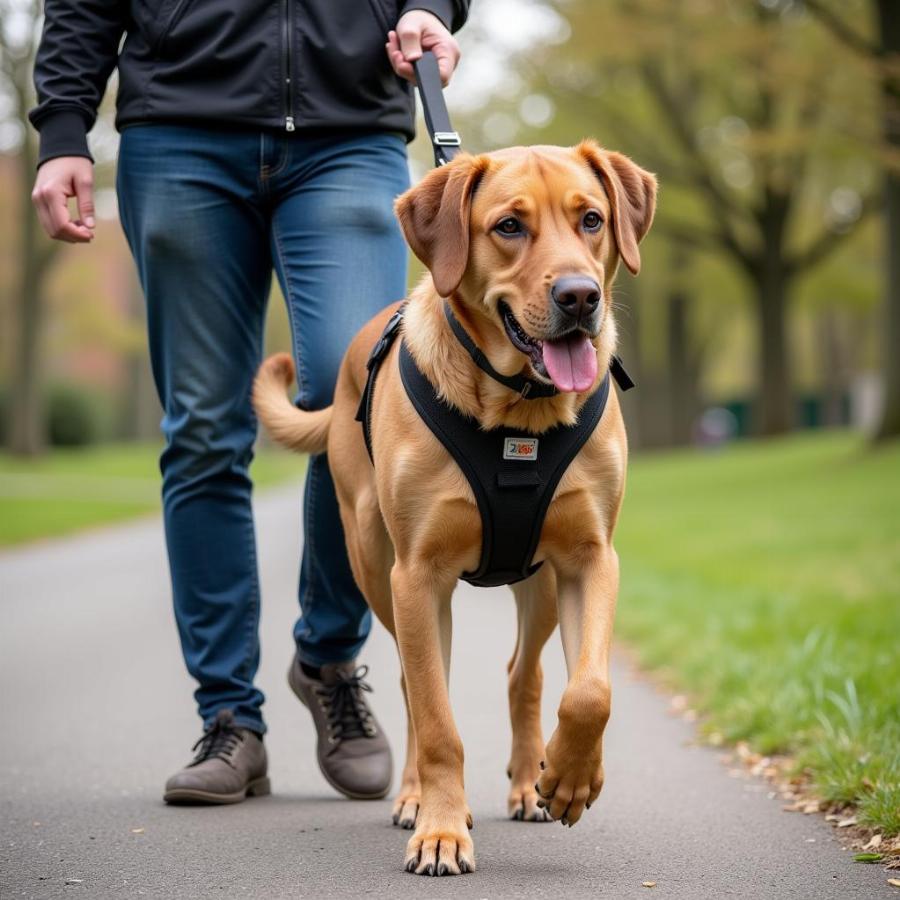Choosing the right dog harness for your large breed companion is crucial for both their comfort and your control. A well-fitted harness can make walks more enjoyable, training sessions more effective, and even provide added safety in various situations. But with so many options available, finding the perfect fit can be overwhelming. This comprehensive guide will delve into everything you need to know about dog harnesses for large dogs, helping you make an informed decision for your furry friend.
Types of Harnesses for Large Dogs
Choosing a harness depends on your dog’s size, breed, and temperament, as well as your intended use. There are several types of harnesses available, each designed for specific needs.
Front-Clip Harnesses
Front-clip harnesses are great for dogs who tend to pull. By attaching the leash to the front of the chest, you can gently redirect their attention and discourage pulling. This type is particularly helpful for training puppies or strong, energetic dogs.
Back-Clip Harnesses
Back-clip harnesses offer more freedom of movement for dogs who walk calmly on a leash. The leash attachment point is on the dog’s back, distributing pressure evenly and reducing strain on the neck. This is a good option for well-behaved large breeds.
Dual-Clip Harnesses
Dual-clip harnesses offer the versatility of both front and back leash attachments. This allows you to switch between the two depending on the situation. For instance, you can use the front clip for training and the back clip for relaxed walks.
No-Pull Harnesses
 Áo harness chống kéo cho chó lớn
Áo harness chống kéo cho chó lớn
No-pull harnesses are specifically designed to deter pulling. Some have a front clip, while others use gentle pressure points to discourage pulling without causing discomfort. These harnesses are often a good solution for persistent pullers.
Finding the Right Fit for Your Large Dog
Proper fit is paramount for comfort and safety. A harness that’s too tight can restrict movement and cause chafing, while a loose harness can allow your dog to slip out.
Measuring Your Dog
To determine the correct size, you’ll need to measure your dog’s chest girth, which is the circumference around the widest part of their chest, usually just behind the front legs. You should also measure their neck girth, just below where their collar sits. Refer to the manufacturer’s size chart for specific measurements.
Adjusting the Harness
Once you’ve chosen a harness, adjust the straps to ensure a snug but comfortable fit. You should be able to fit two fingers between the harness and your dog’s body. Ensure the harness doesn’t restrict movement or rub against the skin.
Materials and Durability
Large dogs need durable harnesses that can withstand their strength and activity levels. Look for harnesses made from strong materials like nylon or polyester. Reinforced stitching and heavy-duty hardware are also essential for longevity.
What if my dog is extra large?
If your dog falls into the “extra large” category, you’ll need to look specifically for harnesses designed for their size. These harnesses often have wider straps and more robust hardware to accommodate their weight and strength. Check out our guide on dog harness for extra large dogs for more information.
Safety Considerations
A harness plays a vital role in your dog’s safety, especially during car rides. For safe travels, consider a dog leash for car that can attach to your car’s seatbelt system.
Conclusion
Choosing the right dog harness for your large dog is an investment in their well-being and your peace of mind. By considering your dog’s needs, activity level, and the various harness types available, you can find the perfect fit for a more enjoyable and controlled walking experience. Remember to prioritize proper fit, durable materials, and safety features.
FAQ
Q: What type of harness is best for a large dog that pulls?
A: Front-clip or no-pull harnesses are generally recommended for dogs that pull.
Q: How do I measure my dog for a harness?
A: Measure the circumference of your dog’s chest and neck. Refer to the manufacturer’s size chart for specific sizing recommendations.
Q: What materials are best for large dog harnesses?
A: Durable materials like nylon or polyester with reinforced stitching and heavy-duty hardware are ideal.
Q: How tight should a dog harness be?
A: You should be able to fit two fingers between the harness and your dog’s body.
Q: Can a harness be used for car rides?
A: While some harnesses can be used for car rides, it’s recommended to use a specialized car restraint for optimal safety. If your dog often joins you on car trips, make sure to check out dog steps into car to make getting in and out of the vehicle easier for them. Also, consider a dog puffer coat for colder weather travels.
Thinking about a new harness?
Need help finding the perfect harness for your furry friend? Consider these additional resources:
- Harness for large dog: harness for large dog
Beaut Dogs is your trusted source for all things canine. We’re passionate about providing dog owners with the knowledge and resources they need to care for their beloved companions. When you need support, please contact us via Email: [email protected], and Beaut Dogs will be happy to provide detailed and accurate answers. We’re here to help you navigate the wonderful world of dog ownership. Visit https://beautdogs.com today!